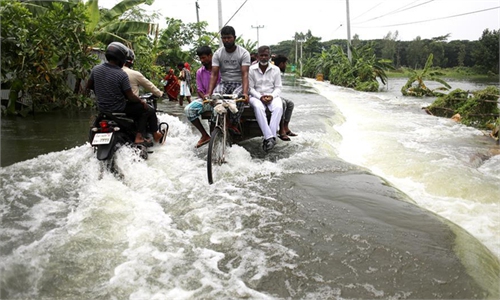China and Bangladesh create a new chapter in the fight against COVID-19
BRI ties demonstrate rich relations

The Chinese-built Padma Bridge Project is Bangladesh's largest bridge project. Photo: Xinhua
Bangladesh is the first country in South Asia to actively respond to the Belt and Road Initiative (BRI). Both China and Bangladesh are developing countries with large populations, similar national conditions, common development goals, and highly complementary industries. We are natural partners for building the Belt and Road together.
During President Xi Jinping's state visit to Bangladesh in October 2016, the two sides signed a memorandum of understanding regarding cooperation under the BRI, and decided to elevate bilateral relations to a strategic partnership of cooperation, providing a new opportunity for win-win cooperation between the two countries.
Since then, the bilateral relations have shifted gears and accelerated on a track of rapid development. China has been Bangladesh's largest trading partner many years in a row, and now this mutually beneficial cooperation has reached historical new heights.
The COVID-19 pandemic has delivered a rare shock to humanity, and Bangladesh is still facing severe challenges brought on by the rapid spread of the virus. China and Bangladesh have supported each other, helped each other, and engaged in positive interactions throughout hard times such as these, vividly illustrating the rich potential of the Belt and Road as a model of cooperation, health, and development going forward.
A path of building consensus
The BRI is a path of building consensus and cooperation. During the virus outbreak, the top leaders of the two countries have managed the overall situation and laid a solid foundation for cooperation. In February, Prime Minister Sheikh Hasina sent a letter to President Xi, stressing the traditionally friendly relations between China and Bangladesh, firmly supporting China in its fight against the pandemic and offering assistance within its capacity.
On May 20, leaders of the two countries conducted "telephone diplomacy" and spoke highly of the mutual support between China and Bangladesh during the COVID-19 pandemic, reaffirming their joint commitment to the global response to the outbreak, and reaching important consensus on issues such as international joint prevention and control and practical cooperation in various fields.

Chinese Ambassador to Bangladesh Li Jiming Photo: Courtesy of the Chinese Embassy in Bangladesh
Safeguarding public health
Medical cooperation between China and Bangladesh has always been an important part of the Health Silk Road.
In April, the Chinese Embassy in Bangladesh invited Zhang Wenhong, a prominent Chinese infectious diseases expert from Shanghai's Huashan Hospital, to exchange experiences online with officials and experts in Bangladesh - a good start for sharing China's experience in fighting COVID-19.
In June, one important outcome of the phone call between President Xi and Prime Minister Hasina was the Chinese government's decision to send medical experts to Bangladesh to talk to local medical personnel and submit a formal written proposal to the Bangladeshi government about how the country could take a more targeted approach to anti-pandemic measures under professional guidance.
At present, the two sides are actively negotiating the technical details of vaccine research and development cooperation. Relevant practical measures will surely benefit the Chinese and Bangladeshi people, and the China-Bangladesh Community of Public Health will surely make indelible contributions to the health of both countries' peoples.
A route to common prosperity
During the pandemic, the Belt and Road cooperation projects between China and Bangladesh, including the Padma Bridge Project and the Karnaphuli River Tunnel, never ceased. In May, unit one of the country's biggest 2*660 MW Payra coal-fired power plant was completed and approved for operation, and began supplying power to Bangladesh's national grid.
On August 2, the Karnaphuli Tunnel project achieved a breakthrough with the completion of the left line. In July, China granted zero-tariff treatment to 97 percent of Bangladeshi tax items, ushering in a new golden era for Bangladeshi exports to China and foreign investment.
The achievements of the Belt and Road cooperation in infrastructure, as well as in economic and trade relations, have clearly benefited the peoples of both countries. China's gross domestic product grew 3.2 percent year-on-year in the second quarter, and was up 11.5 percent month-on-month, according to China's National Bureau of Statistics.
Against the backdrop of a global economic downturn, this exciting news, while showing the resilience of China's economy, has undoubtedly brought confidence and hope to countries around the world, including Bangladesh. China and Bangladesh have both the determination and the ability to share their experiences in resuming work and production in the post-pandemic era, and continue to promote the joint development of the BRI. China and Bangladesh also have the confidence and wisdom to overcome the difficulties of achieving stable development in a complex situation, which will ensure steady and lasting cooperation going into the future.
This year marks the 45th anniversary of China-Bangladesh diplomatic relations. Over the past 45 years, China and Bangladesh have respected, understood, and supported each other, carried forward their traditional friendship, and actively responded to each other's core concerns.
China and Bangladesh will continue to fully tap the huge potential of the BRI, and promote the joint establishment of the initiative and their respective development strategies, with the two countries' shared goals of high quality, sustainability, and people-centeredness remaining at the forefront.
The author is the Chinese Ambassador to Bangladesh.


